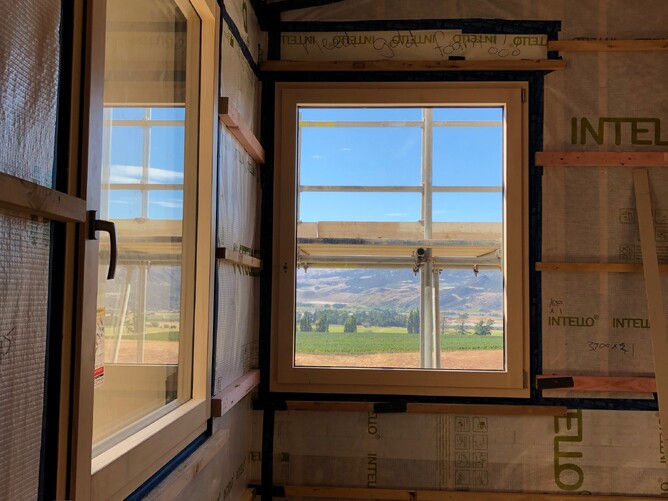Airtightness Explained
Airtight houses are a relatively new arrival in New Zealand, and their advent has created a number of myths and concerns, meaning that their many benefits are often misunderstood and overlooked.
Airtight homes have been enjoyed in Europe for many years, with most European countries including minimum airtightness requirements within their building code, and several have mandatory.
For us, airtightness is mandatory in all our designs, and an essential part of following Passive House philosophies.
The benefits of an airtight house are:
- Lower energy bills due to lower heating and cooling requirements through reduced heat loss and air infiltration.
- Healthier buildings - with reduced chance of mould and rot.
- Fewer draughts - contributing to increased thermal comfort.
- Higher performance ventilation systems – bringing more fresh air into the building.
There are several studies indicating the energy impact of airtight buildings https://en.wikipedia.org/wiki/Building_airtightness, which has led to increased requirements in many countries who are aiming to reduce greenhouse gas emissions as agreed at the 2015 United Nations Climate Change Summit in Paris (and those before).
On average, 40% of all energy usage is created by buildings. Furthermore, on average 40% of a building’s energy use is created by heating and cooling. Therefore, by mandating building airtightness, a nation can have a dramatic effect on its energy usage and greenhouse gas emissions.
A Little New Zealand History
New Zealand does not have any mandatory airtightness requirements, yet as building methods changed in late 1990’s/ early 2000’s with a growing demand for more airtight monolithic cladding, aluminium windows and increased levels of insulation, buildings became more airtight than their timber, weatherboard predecessors. The trouble is that this happened in a way that has caused more of a problem than its potential benefits/solutions. Buildings are now trapping internal moisture within the building cavities which, as they are not properly ventilated or insulated, often createing mould and dampness issues, as well as contributing to health problems (e.g. asthma).
Airtightness – the solution, not the problem
Most New Zealanders are aware of these issues, which has naturally led to a concern that by creating further airtightness, the problem would be added to rather than solved.
This is not the case.
The Proclima study on Airtightness and Moisture Control for New Zealand explains the problem and the solutions in detail (email us for a copy).
Buildings which are airtight retain their heat, which means the heat energy requirements are greatly reduced, and occupants will have lower power bills.
Condensation and dampness occurs when water vapour turns into moisture when it hits a cool surface at the “dew point” https://en.wikipedia.org/wiki/Dew_point. Continual condensation can lead to the creation of mould. If surface temperatures are kept continuously above 12.6°C condensation will not form. By creating a warmer and more consistent internal environment, surface temperatures are naturally higher.
Increasing internal surface temperatures could transfer the moisture and damp issue into the walls or roofs. If moisture transfer into these spaces is not greatly reduced, and the dew point is within the wall depth, this is where condensation will occur.
Airtightness is the way to significantly avoid the transfer of moisture into the fabric of the building. Like a ‘Goretex’ jacket, these membranes still breathe and allow moisture to transfuse at appropriate rates and temperatures, but do not cause a hidden problem.
Airtightness compared to insulation
So, the question is how much difference does “Airtightness” make to your overall comfort compared to insulation.
We have calculated the difference 1 air change per hour (AC/h) makes, in comparison to increasing the insulation of the SIPs panels by 50mm on a 200 sqm house. The answer is surprising.
An increased Airtightness of 1AC/h reduces the heat demand by 5W/m2. This effectively means for every AC/h you save 1kW. (200sqm x 5W/m2=1000W or 1kW)
Increasing the SIPs insulation by 50mm has less than 1W/m2 effect. This means only 180W saving in power (compared to 5x that for airtightness).
Note: this is not a rule of thumb and it would change for different house designs, and how efficient the house is. This house already has achieved a high level of energy efficiency and is compact with good orientation.
Airtightness does not mean you are in a sealed box
Another common myth I hear is that living in an airtight house means I cannot open my doors and windows. It also means I can’t have a wood fire.
Again – not true. You can open your doors and windows as much as you like, when you like, and you can have as many doors and windows as you like. And, you can have a fireplace (though there are specific components and methods to achieving this). We encourage natural ventilation as well as mechanical ventilation to achieve comfort and personal control in your building.
Summary
Airtight buildings are warmer, have fewer drafts and reduced condensation and mould. And being airtight does not mean you need to keep all your doors and windows closed.
By incorporating ventilation systems to continuously expel damp air and bring in fresh air, the internal environment and dampness levels are further reduced. Ventilation can further reduce your energy load and increase your comfort if done correctly.
We should not be afraid of creating airtight buildings, it is more imperative than ever that we do it and do it properly.
By working with us, and applying Passive House design principles, you can be assured of an airtight house and all the benefits that come with it.

